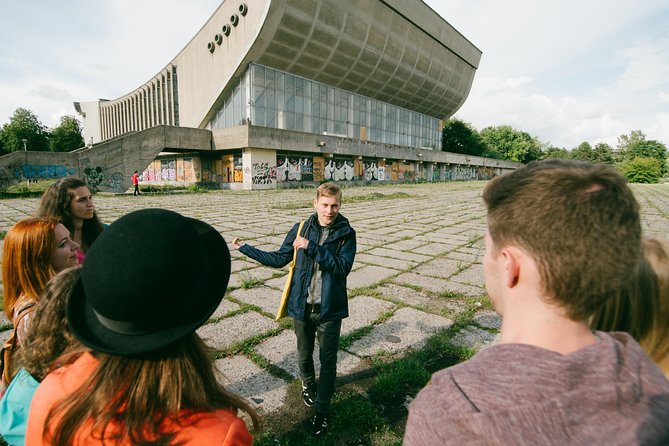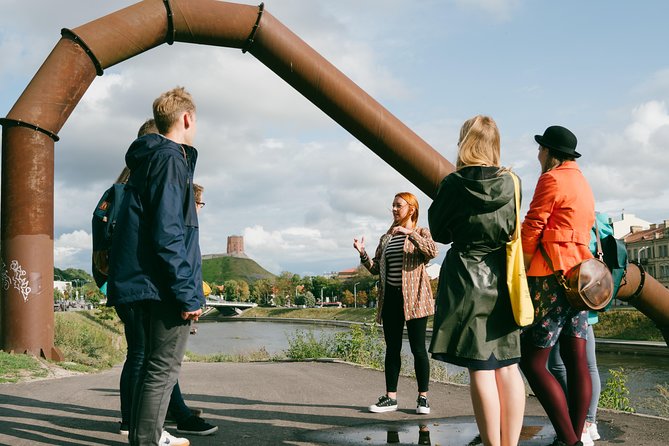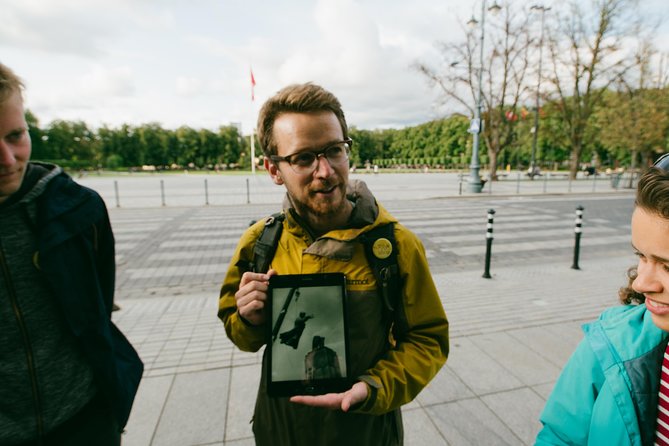Exploring the remnants of Vilnius’ Soviet-era past can provide a captivating glimpse into Lithuania’s resilient history. This walking tour guides visitors through the city’s top architectural landmarks and monuments, uncovering the complexities of life under Communist rule. From the symbolically charged Lukiškių Square to the ominous former KGB headquarters, the tour offers an immersive experience, allowing participants to gain a deeper understanding of the nation’s journey towards independence. Led by knowledgeable guides, the 2-2.5 hour experience promises to leave a lasting impression, revealing the enduring spirit that carried the Lithuanian people through a challenging period in their history.
Key Points

- A 2 to 2.5-hour walking tour that provides an immersive glimpse into Vilnius’ complex Soviet-era history through key architectural landmarks and monuments.
- The tour showcases the city’s central gathering place during the Soviet occupation, the Lukiškių Square, and the Gediminas Monument symbolizing Lithuania’s historical sovereignty.
- Visitors explore the former KGB headquarters, a chilling reminder of the Soviet regime’s oppressive control, and other Soviet-era buildings like the Palace of Concerts and Sport.
- The tour is led by a knowledgeable guide who shares insights into the former Lithuanian Soviet Socialist Republic and the country’s resilience in the face of totalitarian rule.
- The tour begins at the Gediminas Monument in Cathedral Square and concludes at Kudirkos Square, leaving participants with a deeper understanding of Vilnius’ captivating Soviet-era history.
Tour Overview
Exploring Vilnius on this 2 to 2.5-hour walking tour provides visitors with an immersive glimpse into the city’s complex Soviet-era history, showcasing its top architectural landmarks and monuments.
Led by a knowledgeable guide, the tour takes guests through the capital’s historic streets, sharing insights into the former Lithuanian Soviet Socialist Republic. Travelers will visit the Lukiškių Square, Gediminas Monument, and the chilling former KGB headquarters, gaining a deeper understanding of Vilnius’ tumultuous past under Soviet occupation.
Along the way, they’ll also see striking Soviet-era buildings, from the Palace of Concerts and Sport to the Opera and Ballet Theatre. By the tour’s end at Kudirkos Square, you will have a newfound appreciation for Vilnius’ resilience and transformation.
If you're enjoying exploring Vilnius on foot, you'll love these other walking tours we recommend
Highlights of the Tour

The walking tour showcases Vilnius’ iconic landmarks, allowing visitors to enjoy the city’s complex Soviet-era history.
At Lukiškių Square, the guide describes the square’s role as a central gathering place during the Soviet occupation, when it witnessed pro-independence rallies and demonstrations.
Travelers then proceed to the Gediminas Monument, a symbol of Lithuania’s historical sovereignty, learning about the grand duke whose legacy has endured through centuries of foreign rule.
Next, the tour visits the former KGB headquarters, a chilling reminder of the Soviet regime’s oppressive control over the country.
The guide also points out Soviet-era buildings like the Palace of Concerts and Sport, the Opera and Ballet Theatre, and the House of Scientists, showcasing the architectural styles that defined the communist era.
Meeting and End Point

The walking tour begins at the Monument to Grand Duke Gediminas in Cathedral Square, providing an auspicious starting point to explore Vilnius’ captivating history. This iconic landmark commemorates the founding of the Lithuanian capital and serves as a powerful symbol of the nation’s resilience.
As the tour progresses, visitors are immersed in the city’s tumultuous Soviet-era past, bearing witness to the former KGB headquarters and other significant structures that bear the scars of that tumultuous period.
At the conclusion of the tour, visitors are led to Kudirkos Square, just a 5-minute walk from the original departure point, leaving them with a deeper understanding of Vilnius’ complex and compelling story.
Tour Details

This walking tour of Vilnius has received 170 positive reviews, earning it a Badge of Excellence from reviewers. It accommodates a maximum of 15 travelers at a time, providing an intimate and personalized experience as participants explore the city’s captivating Soviet-era history.
The tour’s cancellation policy offers a full refund up to 24 hours before the scheduled start, allowing for flexibility in planning. Throughout the 2 to 2.5-hour experience, a professional guide leads visitors, ensuring they grasp the significance of the landmarks and gain a deeper understanding of Vilnius’ complex past.
The tour highlights include:
- Lukiškių Square
- Gediminas Monument
- Former KGB headquarters
- Soviet-era buildings (Palace of Concerts and Sport, Opera and Ballet Theatre, House of Scientists)
Vilnius’ Soviet-Era History

During the tour, visitors will explore Vilnius’ complex Soviet-era history, uncovering the city’s captivating past under Communist rule.
The former KGB headquarters, once a symbol of Soviet oppression, now stands as a sobering reminder of the nation’s struggle for independence.
Alongside this ominous landmark, the guide will showcase the iconic Palace of Concerts and Sport, the Opera and Ballet Theatre, and the House of Scientists – architectural relics that bear witness to the regime’s efforts to shape the cultural landscape.
Guests will gain a deeper understanding of Lithuania’s resilience in the face of totalitarian control, and the enduring spirit that ultimately led to the country’s liberation.
- Tour From Vilnius – Riga via the Hill of Crosses, Rundale, Bauska
- Hot Air Balloon Flight Over Vilnius or Trakai in Lithuania
- Regular Mountain Bike Tour to Pavilniai Regional Park
- Hot Air Balloon Flight Over Vilnius Old Town
- CITY QUEST Vilnius: Unlock the Mysteries of This City!
- Three Capitals of Lithuania: Trakai, Kernave, Vilnius
Exploring Lukiškių Square

Lukiškių Square’s storied past reflects Vilnius’ complex journey through Soviet occupation and the nation’s hard-fought battle for independence. Once a hub of political demonstrations and rallies under Communist rule, this historic plaza now stands as a symbolic testament to Lithuania’s resilience.
The massive Monument to the Victims of the Genocide and Resistance, honoring those who perished under Soviet and Nazi regimes.
The former Red Army House, now home to the National Museum of Lithuania, chronicling the country’s turbulent 20th-century history.
Remnants of the Berlin Wall, a poignant reminder of the divisions that once characterized Eastern Europe.
The restored Vilnius Cathedral, a symbol of Lithuania’s Catholic heritage and renewed national pride.
Gediminas Monument and Legacy

Situated at the heart of Vilnius’ Cathedral Square, the Gediminas Monument stands as a proud testament to the legacy of the Grand Duke who established the Lithuanian capital in the 14th century.
This towering bronze statue honors Gediminas, the visionary ruler who transformed the city into a thriving political and cultural center, leaving an indelible mark on Vilnius’ enduring identity.
The monument depicts Gediminas on horseback, surveying the city he founded and symbolizing the strength and determination that shaped Lithuania’s rich history.
As visitors gaze upon this iconic landmark, they’re reminded of the pivotal role Gediminas played in shaping the very fabric of Vilnius, leaving a lasting impression that continues to inspire and captivate.
Former KGB Headquarters

The former KGB headquarters in Vilnius stands as a chilling reminder of the Soviet regime’s oppressive grip on the city, its imposing façade casting a shadow over the surrounding streets. Visitors can explore this notorious building, now a museum documenting the KGB’s dark legacy and the struggles of the Lithuanian people under Soviet occupation.
Walking through its corridors, one can almost feel the weight of the countless personal tragedies that unfolded within its walls, a somber testament to the price paid for Lithuania’s hard-fought independence.
The museum offers a comprehensive insight into the KGB’s operations, including:
- Exhibits detailing the organization’s structure and tactics
- Personal accounts and testimonies from victims of Soviet oppression
- Artifacts and documents that shed light on the KGB’s surveillance and interrogation methods
- Interactive displays that immerse visitors in the historical context of the Cold War era.
Frequently Asked Questions
What Is the Dress Code for the Tour?
The tour does not have a strict dress code. Visitors should wear comfortable walking shoes and dress casually, as the tour involves extensive walking through the city. Light layers are recommended to accommodate changes in weather.
Are There Any Bathroom Breaks During the Tour?
The tour doesn’t explicitly mention bathroom breaks, but the 2-2.5 hour duration suggests there may be an opportunity to use facilities along the route. The guide can likely accommodate requests for stops if needed.
Can We Take Photos During the Tour?
Yes, participants can take photos during the Vilnius Soviet-era history tour. The guide encourages capturing the city’s unique architecture and landmarks to remember the tour’s informative insights about Vilnius’ fascinating Soviet-era history.
Is the Tour Suitable for Children?
The tour is generally suitable for children, as it offers an educational and engaging exploration of Vilnius’ Soviet-era history. However, some content may be sensitive, so parental discretion is advised. The guide can provide child-friendly explanations if requested.
Can We Purchase Souvenirs Along the Tour Route?
Yes, there are opportunities to purchase souvenirs along the tour route. The guide can point out local shops and markets where visitors can find a variety of Lithuanian handicrafts, traditional folk art, and Soviet-era memorabilia.
Recap
This walking tour of Soviet-era Vilnius provides a captivating glimpse into Lithuania’s complex history under Communist rule.
Visitors explore the city’s architectural landmarks, monuments, and former KGB headquarters, gaining a deeper understanding of the nation’s resilience and journey towards independence.
The tour’s insights into Vilnius’ Soviet past make it a must-do experience for anyone interested in this pivotal chapter of Lithuanian history.
More Walking Tours in Vilnius
More Tours in Vilnius
- The Hill of Crosses: Full-Day Tour from Vilnius
- Dzukija National Park and Grutas Park: Full-Day Tour
- Vilnius: Trakai Tour with Audio Guide and Minibus Transfers
- Lithuanian Cheese Tasting & Guided Old Town Tour
- Vilnius: Private Paneriai Park, Trakai Castle, Kernav Tour
- Vilnius: Walking Tour with a Local Guide – Small groups
More Tour Reviews in Vilnius
- Vilnius: Then and Now Private Old Town Tour
- Vilnius : Sightseeing Walking Custom Tour with a Local Guide
- Vilnius: Customized walking day/night tours around Vilnius
- Vilnius Safari Quad Bike Adventure
- Sightseeing Tour to Kaunas and Paaislis Monastery
- Vilnius: Hill of Crosses, Rundale Palace, Bauska Castle Trip
Not for you? Here's more things to do in Vilnius we have recnetly reviewed
- Vilnius: 1-Day Bike Rental
- Vilnius, Trakai and Kernave Private Full-Day Tour
- The Majestic and Royal Vilnius Walking Tour
- Vilnius Private Photoshoot Tour
- Vilnius Old Town walking tour with snacks
- Vilnius Go-Karting Adventure
- The Taste of Lithuania PRIVATE
- Vilnius: Discover 50+ Top Attractions with Vilnius Pass
- Vilnius:Hot Air Balloon Flight Over Trakai or Vilnius
- Lovely Walking Tour Around Vilnius During Christmas Time
- Vilnius: Private Tour with a Local Host
- Vilnius: Private City Bike Tour of Vilnius Highlights
